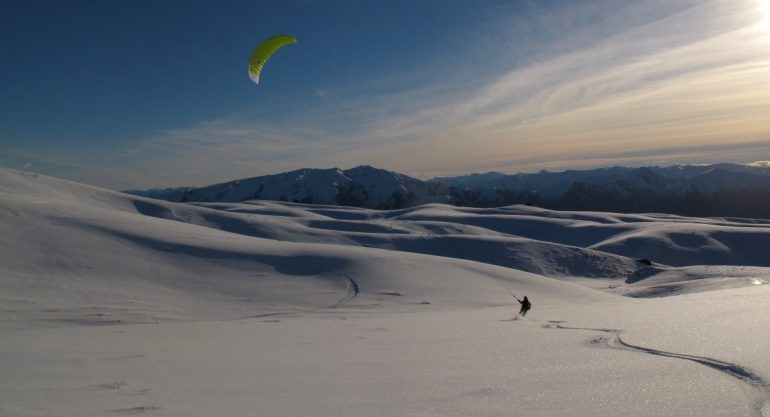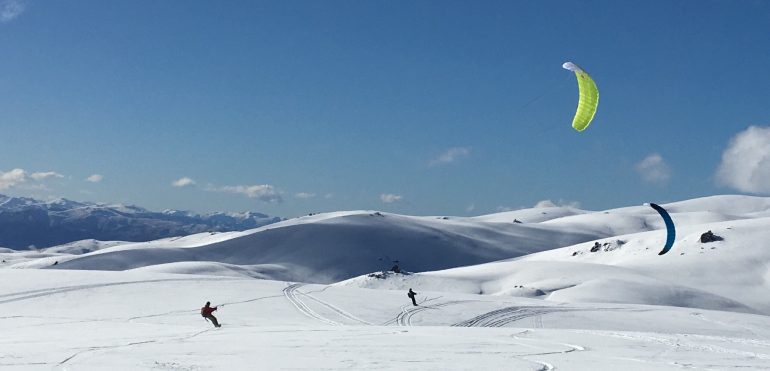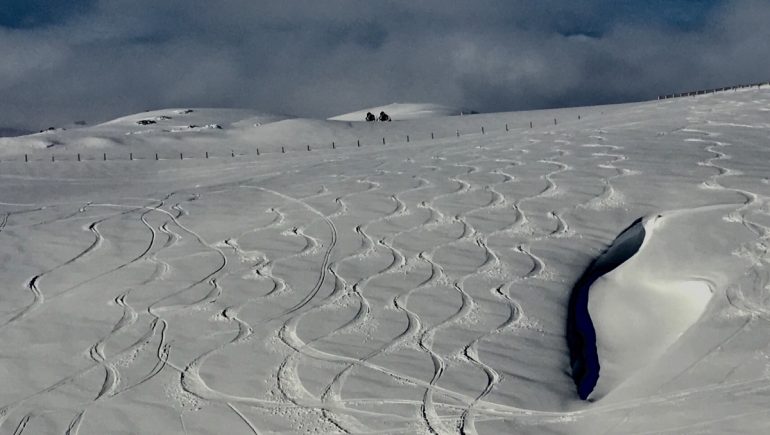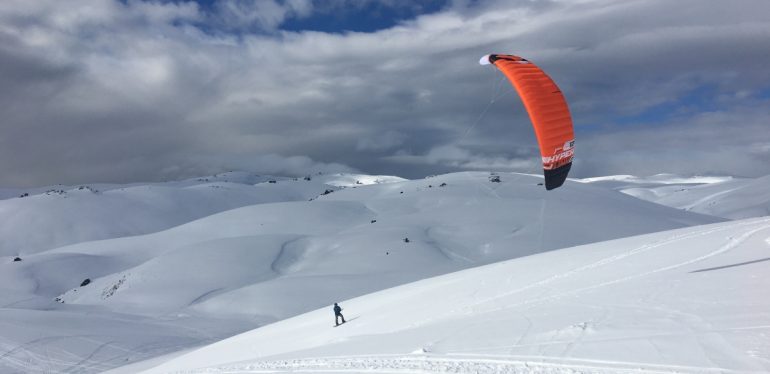
A sunset pow session on Mt Pisa in southern New Zealand. When it all comes together – wind, snow, visibility and skills – your backcountry tours enter a whole new universe of fun and possibilities.
Learning to sail on snow in the New Zealand backcountry
Words and photos by Derek Grzelewski
In the carpark of the Snow Farm, on the slopes of the Pisa Range in southern New Zealand, I used to see them coming back – tired, cold and wind-burnt but buzzing with excitement and wide-eyed with wonder. The snow kiters! On skis or snowboards, tethered to colourful kites, they would sail off into the arctic landscapes of Mt Pisa and return with tales of covering 50 or more miles of remote backcountry in just a couple of hours, and acres upon acres of untracked powder worth several days of heli-skiing which they had all to themselves. But for me, the final jolt of inspiration came from the documentary film Mountains of the Wind, an informal history of snow kiting, in the words of Noah Poritz, one of the sport’s pioneers.
“Quickly, I realized I don’t need a lift ticket anymore,” Poritz was saying. This somehow encapsulated an irresistible idea: a personal ski lift in your backpack, a wing to unfold and sail over pristine and otherwise inaccessible backcountry snow. And so, well before the arrival of winter, I had a three-meter trainer kite, aptly named Ignition, and began flying it in my local park. In New Zealand kids learn to sail long before they get to drive cars, but I was a total wind-sport rookie, for the first time touching the power of the wind and learning its ways. Then, with the first snow and wind of the season, I found myself on the beginners’ slopes of the Pisa Range learning to ski again, only this time while being pulled along by the power of the kite.
Even after the initial taste of the sport, it became apparent that southern New Zealand is something of a snow kiters’ paradise. The Central Otago block mountains — The Old Man and Old Woman Ranges, St. Bathans, Hawkduns, Garvie and Mt. Pisa — flat-topped mesas, high and desolate, covered in snow for most of winter, and above all, exposed to the wind, are ideal snow kiting destinations. This however, does not make the learning progression any easier.

The kite beginners’ slopes on Mt Pisa. Master your basic snow kiting on near-flat terrain before taking it into the steeps and riding fall-lines.
“There are no schools or instructors in New Zealand,” mountain guide and the godfather of kite skiing in this country Whitney Thurlow told me during a brief introductory session I begged from him. “You have to kinda figure it out by yourself and the trick is to get through the beginners’ stage without getting too beat up!” Daniel Clearwater, a former navy helicopter pilot and a fellow snow kiting rookie only a few days ahead of me put it another way: “It’s like riding a dragon – awesome and exhilarating – but every so often you can get bitten.”
The greatest danger in the early stages of snow kiting is of course being overpowered by your dragon, and losing control over it, so it dives into the wind zone of maximum power and pulls and spins and spirals there, potentially dragging you over the landscape until you yank the ejection chord which completely depowers the beast. Any rookie could be put off by such ordeals but on my first day on the slope I was lucky enough to meet Sue Bradley who, although also a kiting beginner, was already well-versed in the ways of the wind.
A life-long windsurfing instructor, national-level competitor and a skipper of ocean-going yachts now approaching her retirement, Sue wasn’t about to be messed by an unruly dragons in the wind. “I spent almost all my time up here last winter with a small and forgiving trainer kite, feeling how it works and seeing how it can pull me on skis,” she told me. “You get overpowered, you simply let go of the kite and it falls down without pulling you. Going too big too fast and too soon can be dangerous. But snow kiting can be learnt safely, you just have to respect the wind, and your own abilities and limits.”
Over the following days, we spent most of our time plodding about in deep snow, untangling lines, launching and crashing our kites, being pulled around the hill slowly and in control, only occasionally leaving a snow angel here and there, a sure sign of making progress. With another couple of enthusiasts, we naturally formed a fellowships of the rookies, keeping an eye out for each other, while the expert kiters whizzed by and disappeared far into the backcountry, to plunder its powder stashes. When the kites are up and flying, kiting is not really a social sport – the kite lines are 25 meter long and so everyone needs around them a moveable half dome of safe air space, especially downwind, because two kites tangling together could be disastrous – but we bridged these distances by using paragliding radios so we could chat while being miles apart, offering tips, suggestions and an odd joke.

Sailing off into the “great white” of Mt. Pisa where you can find more powder than your legs can handle and only the best friends to share it with.
By about day four I was reading a book on sailing, about points of sail and angles, and it all slowly began to make sense. On day six I covered nearly 20 miles, most of it upwind and uphill – which is the hard part – and then managed to come back to base all by kite power, and for the first time I too was “ tired, cold … but buzzing with excitement and wide-eyed with wonder,” so elated as if I had just crossed Antarctica by kite.
Still, beyond the basics snow kiting is not as simple as hooking yourself to a kite and sailing away, albeit in control. It is a complex game with many variables and moving parts. First you have the mountain wind, not your steady sea breeze, but unpredictable and changeable both in strength and direction. Then you have the kite, the aforementioned dragon chomping at the bit to run with that wind and you dare not take your eyes of it, or your hands off its reins. Then there is the terrain, too: rolling hills with gullies and ridges, crests where the wind is strongest and hollows where it drops completely so that your kite falls out of the sky, becalmed and limp. Snow too can change, from powder to crust to sastrugi. And did I mention other kiters and the rules of traffic to pass each other safely, rocks, patches of tussock grass, and an odd disused barbed-wire fence, partly buried in the snow but strong enough to trip you up or snag your kite?

Some days it’s like “mowing the lawns,” line after fresh line, all to oneself. No skins were used in tracking out of this hill (which took only about 30 minutes).
Snow kiting is not so much physically tiring as it is mentally intense, engaging both the mind and the body so completely there is no time or space for anything else but being “in the Zone” which perhaps explains why the sport is almost addictive and why it appeals to such a wide range of snow enthusiasts.
Only a decade ago, snow kiting was a fairly extreme sport. But then, along came Ozone, a New Zealand-based company which, though small in size, has managed to dominate the global kiting scene ever since. Pretty much everyone who is anyone in the world of kiting, both on snow and water, flies Ozone, and tellingly this includes the originators of snow kiting, the French brothers Pascal & Cedric Joubert. Robbie Whittall, Ozone’s design whiz, is a former paragliding world champion, and he’s brought the top-end paraglider technology into kiting, focusing not just on performance but above all on safety and enjoyment. His innovations, like the Megatron release (the ejection handle to disconnect yourself from the kite) and the fifth-line 100 percent depower (which completely stalls the kite so it can not pull anymore) have revolutionized the sport and made it widely accessible and not just the domain of super-athletes.

Kite-making technology is continually and rapidly evolving. Here, OZONE Kites’ co-founder Matt Taggart is playing with Hyperlink, a high-performance snow kite that can also be used on water.
For one, I am infinitely grateful for this inclusion. After the first few slow and frustrating days, I was finally getting off the beginners’ zone and to the edge of Pisa backcountry, when Whitney Thurlow pulled over in a graceful turn, his behemoth of a kite eager but obedient like one of those mountain banshees in the Avatar movie. “If you’ve made it this far, you’re not a rookie anymore,” he grinned. “You’ve done the hardest part. Welcome to the tribe.”
And since the wind was good and the powder fresh, he did not linger but sailed off towards the rolling hills of the summit. I pulled on the reins, and my dragon found the wind too and we followed the best I could, the snow around us sparkling like diamonds and whooshing from under my skis.
All that happened a few years ago and since then I’ve had no shortage of powder days powered by kites. They are perhaps not as steep as you’d get touring but often a lot longer and more effortless. Did I mention that, while snow kiting, you get to do your fresh lines down and UP the hill? Skiing fall-lines, while flying the kite, is also something of a dark art but it comes with time and mileage. When you finally get it, you can ski out an entire mountain as if you were mowing a lawn on it, line after line, down and up. For me, it turned out to be one of the most exhilarating things I’ve ever done in my life.
The oddest thing too is that I used to hate the wind. Now, I can’t wait for it.
How to get into kite skiing:
Before winter, get a trainer kite like the 3m Ozone Ignition and fly it as much as you can in a safe obstacle-free zone. Find and watch YouTube clips about “wind window,” how to generate pulling power and how to control it. You want to become so familiar with the kite and its power zones that you can find and feel them without looking. Kite skiing or boarding on snow is kiting first, riding second. Even if you fall over, you still need to fly the kite or it’ll drag your butt through the powder you’re meant to ride on your planks.
When the snow comes you can and should still use your trainer for the first few sessions. Start on flat terrain and work up to hills. Going uphill and upwind is the hardest. As you get more comfortable, you upgrade to a beginner’s 5-line kite like Ozone PURE or ACCESS in the 6-8m range. At the beginning you’ll tangle up a lot, this is normal. Learn the primary and secondary safety releases so you can deploy them without thinking and with your eyes closed
Get a wind speed meter (called anemometer) and learn to use it and match the size of your kites to wind speeds. As you gain confidence, you progress to bigger kites, perhaps up to 13 m.
Watch this complete video tutorial on snow kiting. Ozone Kites also has its own how-to series.
After some 10-15 days of kiting you may feel ready to explore some backcountry. For that we usually carry two kites, big and small (mine are 6 and 11 m) and swap them according to the wind. You still need your full backcountry kit, including skins, for times when the wind drops or turns into a gale.
Check out this documentary that follows kite skiers around the world.
Fly safe, have fun!
Writer, backcountry aficionado and kite skiing convert Derek Grzelewski is now based in Colorado where he’s exploring kite skiing zones whenever the wind is strong enough. He also ski guides in Japan and has a strong association with OZONE Kites where he can help you source and choose the best and safest kites for your backcountry needs. For all kite gear inquiries, you can follow him his website.
Beyond our regular guest bloggers who have their own profiles, some of our one-timers end up being categorized under this generic profile. Once they do a few posts, we build a category. In any case, we sure appreciate ALL the WildSnow guest bloggers!
